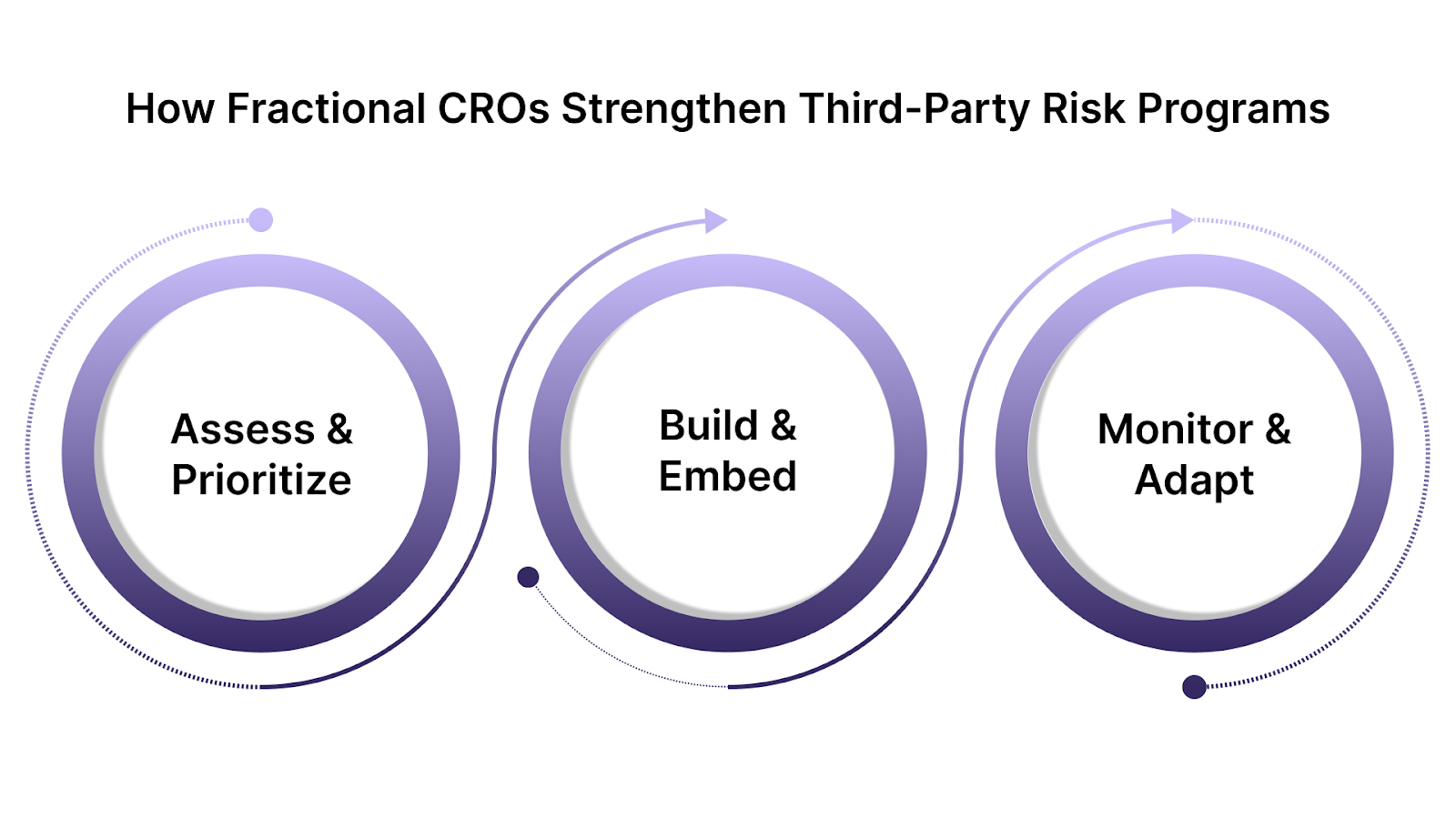Nov 13, 2025
Fractional CROs and Third-Party Risk: A Smarter Governance Model

By Fraxtional LLC

Modern finance runs on other people’s infrastructure.
APIs, banking partners, cloud vendors, and verification providers have become the plumbing that keeps FinTechs and crypto firms operational. What used to be “outsourcing” is now an ecosystem, one that regulators have started to scrutinize as closely as the institutions themselves.
Recent enforcement actions in the U.S. show a clear pattern: when a vendor fails, the accountability doesn’t stay with the vendor. It moves upward to the firm that relied on them.
For many startups, that moment arrives before they’ve built a strong enough internal risk function to respond.
Full-time Chief Risk Officers are rare in early-stage companies.
Yet investor due diligence, sponsor bank relationships, and licensing requirements now demand CRO-level oversight from day one. The gap between compliance expectations and available leadership has created a new model of governance: the fractional CRO.
These on-demand executives bring structure where speed once ruled, helping regulated firms identify, measure, and control third-party exposure without inflating headcount or slowing growth.
Key Takeaways:
- Third-party risk has become the biggest blind spot in regulated industries.
- Many fintechs and crypto startups lack full-time CRO oversight.
- Fractional CROs offer scalable risk leadership at lower cost.
- They build resilient vendor-risk frameworks and ensure compliance with OCC, FCA, and FinCEN.
- Fraxtional provides on-demand CRO expertise tailored to your regulatory needs.
What Is a Fractional Chief Risk Officer?

A fractional Chief Risk Officer is a senior executive who oversees an organization’s risk framework on a part-time or project basis.
They bring the same strategic depth as a full-time CRO, setting risk appetite, shaping governance structures, and ensuring compliance alignment, but operate through flexible engagement models suited to early-stage or fast-scaling firms.
In the FinTech and banking ecosystem, this model has become less of a convenience and more of a necessity.
Sponsor banks expect risk leadership in every partner they underwrite.
Crypto exchanges face similar pressure from custodial and counterparty requirements.
Investors, too, increasingly ask who signs off on risk before capital moves.
The fractional CRO steps into that space. They translate regulatory language into operational reality, connecting vendor management, cybersecurity, compliance, and board reporting under one cohesive view.
Unlike consultants who produce audits or frameworks and move on, fractional CROs stay embedded long enough to shape behavior, guiding founders, risk managers, and compliance teams toward sustainable discipline.
Why Third-Party Risk Needs Fractional CRO Leadership

Across financial services, external dependencies have grown faster than the internal controls designed to manage them. According to the EY 2025 Global Third-Party Risk Management Survey, 57% of companies identified disruption to business operations as their top third-party risk exposure. Yet, in many mid-market FinTechs and digital banks, vendor oversight still sits within compliance checklists rather than enterprise-level governance.
This gap now carries measurable consequences.
The OCC and Federal Reserve expect third-party oversight to be as rigorous as internal controls, holding institutions accountable for vendor lapses. FinCEN takes a similar view in crypto and payments, where money-transmitter licensees must demonstrate continuous oversight of custodians, KYC providers, and exchange partners.
Fractional CROs bring structure to this fragmented landscape. They design and enforce vendor-risk frameworks that map dependencies, assess concentration risk, and tie every external partnership to a defined control owner.
Their remit spans due diligence, contract governance, data-handling standards, and board-level reporting, all without the cost and permanence of a full-time executive.
In high-growth regulated environments, that combination of independence and accessibility is often what keeps compliance scalable.
It replaces reactive vendor reviews with ongoing visibility, enabling firms to demonstrate credible risk governance to investors, auditors, and sponsor banks alike.
How Fractional CROs Strengthen Third-Party Risk Programs
Strong vendor oversight isn’t built through policies alone; it evolves through consistent evaluation, ownership, and escalation. Fractional CROs approach third-party risk as a living framework rather than a compliance exercise. Their process typically follows three phases designed to create structure without bureaucracy:

Phase 1:
Assess and Prioritize
The first step is clarity. Fractional CROs map every external dependency from technology providers and data processors to sponsor banks and payment partners and classify them by criticality. Each vendor is scored for operational, regulatory, and reputational exposure using defined criteria: data sensitivity, geographic reach, and control maturity.
This phase establishes visibility, a prerequisite for every subsequent control. It also surfaces shadow vendors or unmonitored integrations that often escape internal audits.
Phase 2:
Build and Embed
Once the risk landscape is visible, the CRO designs the governance around it. That includes policies for vendor onboarding, contractual risk clauses, cybersecurity standards, and ongoing due diligence cycles.
This is where the fractional model adds real advantage; experience drawn from multiple regulated environments allows the CRO to benchmark best practices without inflating internal resources.
They embed these standards into existing workflows so that compliance is sustained by teams, not consultants.
Phase 3:
Monitor and Adapt
Third-party risk doesn’t remain static. Regulatory expectations evolve, vendors scale, and new interdependencies emerge. Fractional CROs implement continuous monitoring routines, automated vendor scorecards, performance dashboards, and independent assurance reviews.
Each cycle feeds back into board reports and audit responses, allowing firms to demonstrate proactive control. Over time, this discipline converts third-party oversight from a reactive obligation into an operational advantage.
Fractional CRO leadership turns vendor-risk management into a repeatable system. Instead of isolated assessments, firms gain a framework that matures with every engagement, clear ownership, measurable outcomes, and documented resilience.
The ROI of Fractional Risk Leadership

For regulated businesses, risk leadership is a function tied directly to funding, licensing, and operational continuity.
Yet, for many growth-stage FinTechs and crypto firms, maintaining a full-time Chief Risk Officer can exceed budget before the function reaches full utility.
A fractional CRO creates leverage at that junction.
Instead of carrying a fixed executive cost, firms gain targeted access to senior leadership during the periods that matter most, funding rounds, regulatory audits, vendor expansions, or sponsor-bank negotiations. Risk governance scales in proportion to business growth.
When modeled over a 12-month cycle, companies engaging fractional CROs typically achieve:
- Cost savings of 40–60% compared with full-time executive compensation.
- Shorter remediation cycles for vendor or audit issues due to external oversight continuity.
- Higher investor confidence, particularly in due diligence phases, where risk documentation influences valuation.
- Improved sponsor-bank approval rates, as partnerships increasingly hinge on visible CRO-level governance.
For boards, the return isn’t just measured in expense reduction. It’s in the assurance that regulatory expectations are met, vendor exposure is transparent, and compliance maturity advances without expanding fixed headcount.
Fractional risk leadership offers a pragmatic way to align governance with growth, rigorous enough to satisfy regulators, lean enough to sustain momentum.
When to Engage a Fractional CRO

The need for risk leadership often becomes visible only when a partnership or audit is already in motion. For most firms, the signal is a moment of scale that outpaces internal structure. Fractional CROs are most effective when introduced before that inflection point.
Common engagement triggers include:
- Entering a sponsor-bank partnership: regulators and banking partners now require clear vendor oversight, risk appetite statements, and escalation protocols before onboarding.
- Expanding vendor or API networks: rapid integrations across payments, KYC, and data systems multiply operational exposure faster than policy updates can keep pace.
- Preparing for licensing or fundraising: investors and regulators increasingly request enterprise-level risk documentation as proof of maturity.
- Recovering from an audit or vendor incident: fractional CROs can stabilize governance, rebuild frameworks, and guide remediation without delaying business continuity.
- Scaling cross-border operations: multi-jurisdictional rules around data, AML, and vendor management demand structured oversight beyond local compliance officers.
Early engagement allows fractional CROs to build risk infrastructure in parallel with growth, ensuring oversight becomes a foundation rather than a retrofit.
How Fraxtional Helps

The real advantage of engaging a fractional Chief Risk Officer is compression of expertise. Instead of taking months to design a third-party risk framework, a fractional CRO delivers a working model in weeks, grounded in regulatory logic and operational reality.
Here’s what that looks like in practice:
- From Manual Reviews to Continuous Visibility
Most firms track vendor risk through spreadsheets and static reports. A fractional CRO replaces that with dynamic dashboards integrating feeds from finance, procurement, and IT to surface early warning indicators like payment anomalies, overdue attestations, or missing SOC reports. - From Departmental Silos to Central Accountability
Fractional CROs establish cross-functional governance models that define who signs off on what, ensuring the same issue isn’t “everyone’s problem” and therefore no one’s responsibility. - From Policy to Proof
Regulators and sponsor banks now demand evidence, not intention. Fractional CROs institutionalize testing control validations, audit trails, and escalation paths so organizations can demonstrate risk management, not just declare it. - From Periodic Audits to Predictive Monitoring
Using AI-driven assessment tools and vendor performance analytics, a fractional CRO shifts the model from reactive checks to proactive risk identification, catching supply chain or compliance threats before they cascade.
Fraxtional’s contribution lies in translating these principles into execution. Its fractional CROs design operating systems for risk: lightweight, transparent, and auditable.
That means founders spend less time firefighting compliance issues and more time scaling responsibly.
Let’s build a framework that scales with your growth.
Conclusion
Third-party risk has evolved from a back-office audit item into a defining factor of business credibility. For fintechs and financial institutions navigating constant regulatory scrutiny, the question becomes how to invest in risk oversight without slowing growth.
The fractional CRO model is fast becoming that middle ground. It allows companies to deploy seasoned risk leadership precisely when complexity spikes during licensing, audits, or sponsor-bank partnerships without the drag of full-time overhead.
More importantly, it injects structure and foresight into operations that typically run on instinct and speed.
For investors, this means greater confidence in governance maturity.
For regulators, it signals accountability without overextension.
And for founders, it delivers what risk management was meant to achieve all along: clarity, not constraint.
Fraxtional enables this shift by embedding experienced CROs who design scalable, defensible frameworks around third-party risk, turning compliance from a reactive burden into a strategic advantage.
FAQs
A fractional Chief Risk Officer (CRO) provides executive-level risk leadership on a flexible basis. They oversee frameworks for compliance, third-party risk, and operational resilience without the cost or commitment of a full-time hire.
A fractional CRO builds structured oversight across vendors, data processors, and service providers. They introduce measurable controls, real-time monitoring tools, and governance policies that align with regulatory expectations.
Because growth in these sectors outpaces internal compliance capacity. Fractional CROs help fintech and crypto companies maintain regulatory credibility, prepare for audits, and manage evolving risks tied to sponsor banks, licensing, and custody partners.
A fractional CRO embeds within the business and owns decision-making authority over risk strategy. Consultants advise; fractional CROs execute, monitor, and report directly to leadership.
Companies typically engage fractional CROs when expanding vendor networks, applying for licenses, or undergoing rapid scaling that exposes gaps in governance and third-party oversight.
blogs
Don’t miss these
Let’s Get Started
Ready to Strengthen Your Compliance Program?
Take the next step towards expert compliance solutions. Connect with us today.




